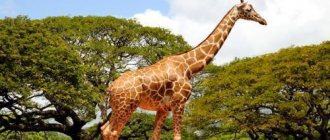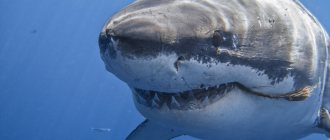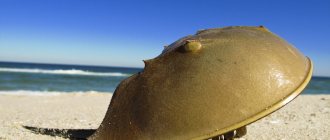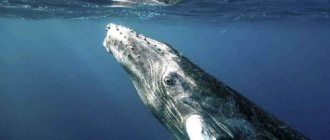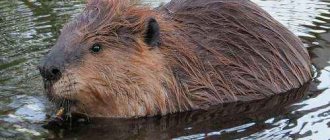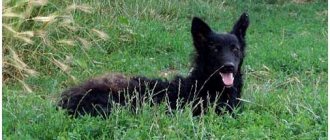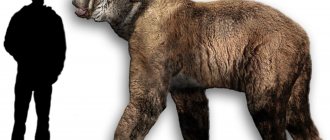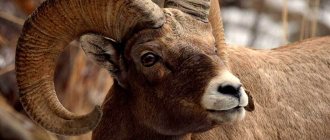Siamese crocodile
Photo: RedGazelle15/Wikimedia Common
Representatives of this species are common in some countries in southeast Asia. They usually grow no more than 3-4 m, but individuals crossed with saltwater crocodiles can have more impressive sizes. They can be found in swamps, on the shores of lakes or in slow-moving rivers. They feed on amphibians, reptiles and small mammals. In many territories, these crocodiles were on the verge of extinction and were listed in the Red Book. According to scientists, there are only about 5 thousand of them left.
The largest prehistoric crocodiles
No matter how incredible the size of modern predators may be, history tells of the formidable giants who lived on the planet during the era of dinosaurs.
Sarcosuchus
Excavations of skeletons in the Sahara have made it possible to recreate the size of the largest prehistoric reptile. The life of Sarcosuchus dates back to the Cretaceous period, and the crocodile lived in Africa. The body length was 12 meters and the weight was 8 tons.
Deinosuchus
Translated, the name of the crocodile sounds like “dinosaur killer.” It is not possible to reliably establish the true size of the predator, since archaeologists found only the skull of the animal. Scientists claim that the huge crocodile reached a length of 16 meters and weighed 9 tons.
Swamp crocodile
Photo: Hari Mohan Meena/Wikimedia Common
Its usual habitats are the Hindustan Peninsula and nearby countries. He chooses swamps, rivers and lakes with fresh water to live. Some individuals settle in artificial shallow reservoirs, and in rare cases, in lagoons with brackish water. Males of this species of crocodiles typically grow up to 3.5 m and weigh no more than 200 kg. But there are specimens 4-5 m in length with a mass of about 600-700 kg. The number of reptiles of this species is steadily declining, which is associated with destructive human activities. To prevent the complete disappearance of these animals, India has special programs aimed at preserving and increasing the population.
Paraguayan caiman, 2 m
Its other name is caiman piranha , it received it because of its clearly visible teeth that are not hidden in the mouth. As the name implies, it lives in Paraguay, as well as Argentina, Brazil, and Bolivia.
It can be of different colors, from light brown to dark chestnut, but transverse dark stripes are also visible against this background. Juveniles are yellowish-green in color, which helps them camouflage. Lives in rivers, lakes, and wetlands.
Males of the Paraguayan caiman are slightly larger than females. Usually it is no more than 2 m in length, but can grow up to 2.5 - 3 m. They feed on snails, fish, and occasionally eat snakes and rodents. Due to their natural timidity, they prefer to avoid large animals.
The caiman can reproduce if it grows to 1.3 - 1.4 m. The offspring usually hatch in March, incubation lasts up to 100 days. Due to the constant destruction of its habitat and poachers, the population is declining. But he is not hunted so often, because... Paraguayan caiman leather is of low quality, not suitable for making boots and wallets.
Mississippi alligator
Representatives of the alligator family belong to the general order of crocodiles. Their main distinguishing feature in appearance is their very wide muzzle. Alligators of this species live in the southeastern states of the United States, preferring to settle in freshwater standing reservoirs. Sometimes they climb into the swimming pools of private houses, scaring local residents. And there is something to be afraid of, because these alligators grow up to 4.5 m. There is information that previously there were individuals with a body length of over 5 m, according to other sources - 6.3 m, and their weight was about 500 kg.
Black caiman
Photo: Jan Willem Kaptein/Wikimedia Common
Another crocodile from the alligator family. It lives in the countries of central South America. The body length of this large predator reaches an average of 4 m or more, and its weight approaches 300 kg. In some places, in particular in the Madeira River, there are caimans about 4.5-5 m long. Black alligators live in large bodies of water and rarely come to land. They feed on a variety of mammals, birds, snakes and smaller crocodiles. Their dark coloring helps them remain virtually invisible during night hunting, and their powerful jaws can easily cope with even the durable shell of a huge turtle.
The largest crocodiles
The habitat of predators is concentrated in tropical zones. The diet consists of animal food. Moreover, the crocodile often comes to land to catch the victim. The speed of movement on the ground reaches 15m/sec. The average lifespan of a reptile reaches 100 years, and the largest specimens a priori belong to old individuals. Crocodiles from the era of dinosaurs reached 12 meters in length. Today these monsters are much smaller.
African narrow-snouted crocodile
The name of the reptile is explained by its appearance. Thus, the narrow snout has a narrow muzzle, for which it is confused with the gharial. It is known that the reptile prefers a solitary existence, flocking into certain flocks exclusively during mating.
Due to the peculiarity of the muzzle, fish and snakes become food for the crocodile. Although, there are attacks on animals and birds. No attacks on humans have been recorded, but the danger of a 4-meter-long individual is difficult to deny. The average size of an adult narrow snout is 3 meters. The male grows up to 300 kg.
Gharial crocodile
Like the narrow-snout, the gharial has an elongated snout. The ratio of mouth length to width is 4:1. The number of teeth in an adult reaches 84. This structure indicates the crocodile’s adaptability to fishing. Although, an autopsy of the caught gharial showed that, in addition to fish, the crocodile does not disdain crayfish, insects and even macaques.
The predator attacks mammals in shallow water, ambushing unsuspecting animals while drinking. The crocodile sneaks up on the victim quietly, and the body is completely under water.
The average individual reaches 4 meters, and the maximum recorded weight was 210 kg. Despite the fact that males are larger than females, there are exceptions. So, in 2008, a female cannibal who ate a relative was caught in Kalimantan. The measurements shocked scientists, because the predator’s body was 4.1 meters.
The gharial crocodile, unlike other species, does not chew, but swallows food. If we are talking about a macaque, then the predator first tears the prey into pieces.
Swamp crocodile
Unlike the species described above, the mager is distinguished by a wide mouth and very sharp teeth. The average size is 2.5 meters. Mostly females are smaller than males. However, facts about the existence of individuals that have grown to 5 meters and weigh 400 kg have been officially confirmed.
In addition to fish, the Mager's diet includes small and large terrestrial animals. The marsh crocodile's hunting on land means that it catches up with its prey and drags it under water. After the victim has choked, the crocodile begins to eat directly. This dangerous species often attacks humans.
The marsh crocodile is characterized by social behavior. Mature individuals adhere to a group lifestyle. Moreover, males often occupy certain territories, protecting the flock from strangers.
Mississippi alligator
One of the largest species is distributed in the USA, in the south and east. The size of an adult alligator reaches 4.5 meters. The length record was 5.8 meters with a weight of 300 kg. The average lifespan of a Mississippi alligator in captivity is 80 years. It is noteworthy that throughout the life of a reptile, its teeth change. So, over the entire cycle they grow to a thousand.
Fish are considered the main diet. The alligator also eats crustaceans, turtles, and small mammals. If the animal’s habitat is located in close proximity to humans, then dogs and even children become victims of the predator. In general, the Mississippi alligator does not attack people. Recorded tragic cases are associated with the fact that a hungry animal confuses a human baby with other prey.
The Mississippi alligator is considered the record holder for the strongest bite. This value is equal to 9452 newtons. But, with such a terrifying grip, the animal has an Achilles heel - weak muscles responsible for instantly opening its mouth.
Central American crocodile
This subspecies was bred in 1920, until that time these representatives were confused with Cuban and American crocodiles. Although, there is DNA evidence recording facts of interspecific crossings, which indicates the genetic proximity of these species.
A characteristic feature of the Central American crocodile is a wide mouth and a strong tail, which increases the average speed of movement in water. The number of teeth is 68. The average individual reaches 3 meters, and the maximum length is 4.70 meters. In captivity, the Central American crocodile lives 80 years. Crocodiles prefer to eat aquatic life and small mammals. The animal prefers to behave cautiously towards humans. But, there are cases when the largest individuals (4.5 meters) attacked children.
Nile crocodile
One of the most dangerous species, terrifying animals and people. There are hypotheses that the Nile crocodile is the longest-living of reptiles. And at the same time, the reptile is also one of the largest. The average individual is 5-6 meters in length. And the weight of an adult male is approaching 1000 kg.
Nile crocodiles feed on fish and land animals. The danger is represented by a sharp leap of the reptile, which, creeping up silently, in one second snacks on an animal gaping on the shore. But those who manage to avoid the fatal leap have a chance to escape, since the Nile crocodile never catches up with the victim on land.
The Nile crocodile is a formidable man-eater. Human casualties from the teeth of a dangerous animal are associated with carelessness while on the water. There are no official statistics on deaths. However, the reptile, due to its developed intellectual component, has become a real and exciting threat to vacationers in Africa.
Sharp-snouted crocodile
The length of the species reaches 6 meters, the muzzle is pointed. The large crocodile feeds on amphibians, fish and turtles. Although it does not pose a danger to people, it successfully hunts livestock. The appearance of the individual is a green body with black stripes.
As they grow older, the body acquires an olive or brown tint. A characteristic feature of a sharp-snouted crocodile is the presence of pronounced tubercles. In the winter season, the reptile prefers to sit out in long, up to 9 meters, burrows, which it first digs on the banks of rivers.
Black caiman
The average size of a caiman is between 2.8 and 4.4 meters. Exceptions are adult 6-meter males weighing up to 1100 kg. The reptile's habitat is the Amazon. And in these places, the black caiman is considered the most terrible predator.
The crocodile preys not only on fish, but also on deer, anacondas, horses and cows. Having captured the victim, the black caiman drags it into the river and waits until the prey stops breathing. It is noteworthy that the predator does not know how to chew food, so it either swallows the victim completely or tears the body into small pieces.
The color of the reptile is black or dark brown, which is convenient for hunting at night.
Saltwater crocodile
The largest living crocodile. The average length is 5 meters and weight is 500 kg. According to unconfirmed information, there are representatives measuring 6.7 meters and weighing more than a ton. But, despite their terrifying size, saltwater crocodiles pose less of a danger to humans than Nile crocodiles.
The palm in size went to the famous Cassius Clay. This is the longest crocodile that lives in Australia today. Not long ago, the titled representative of the paddlefish crossed the 110-year-old threshold. Now the length of the record holder is 5.5 meters, although previously it was even larger.
The brave crocodile lost a piece of its tail in a fight with a fellow crocodile. Cassius was almost knocked out of the honorable first place by Lolong, caught in the Philippines. Reliable information says about 6 meters and 17 cm from the tip of the tail to the nose. But the monster did not live long in captivity. While at the crocodile park, Lolong ate a nylon cord, resulting in the death of the reptile.
In 1945, saltwater crocodiles attacked Japanese soldiers. The number of human victims from the massive jaws of the largest reptiles amounted to 400 people.
West African crocodile
Photo: Marco Schmidt/Wikimedia Common
From the name it is clear where this predator lives. Nile crocodiles are also common in these same territories, with which it is often confused. But representatives of the West African species are significantly smaller in size than their Nile relatives. Their length rarely reaches even 5 m. The diet of young individuals consists of invertebrates and fish; the older generation includes larger animals in their menu. Crocodiles living in Mauritania have adapted to survive even in very dry climates, for which they are also called desert crocodiles. It is interesting that the residents of this state protect crocodiles. They believe that if these reptiles disappear, then the water will disappear with them.
The smallest crocodiles
Man imagines crocodiles as terrible predators of terrifying size. However, there are species that, if encountered, will not pose a danger to humans.
Blunt crocodile
This is the shortest of all species of the alligator family. The length of an adult male does not exceed 1.5 meters, and the weight barely reaches 100 kg.
New Guinea crocodile
Another representative of non-dangerous reptiles boasts a length of 2.7 meters. In appearance, the New Guinea crocodile is often confused with the Siamese. But, in fact, a genetic connection was discovered with the Philippine crocodiles of Australia.
Gangetic gharial
The only representative of the gharial genus. It differs from all other crocodiles in its very narrow, elongated jaw, which helps it in hunting fish. The average body length of the gharial is 4-4.5 m, but some individuals grow up to 5 and 5.5 m. There is evidence of a 6-meter giant. These predators weigh less than other crocodiles; the measured specimens were only 159 and 181 kg. Gangetic gharials are common in the north of Hindustan and on the Indo-Gangetic Plain.
Sharp-snouted American crocodile
Photo: Henry Forson/Wikimedia Common
Lives in the tropical waters of North and South America. Prefers to settle in mangrove swamps, river mouths and lakes. It can be found in both fresh and salt water. The maximum body length of representatives of this species reaches 6 m; such giants are found in the basins of South American rivers. Individuals living in continental rivers rarely grow more than 4 m, and crocodiles from islands and coasts are even more modest in size.
Orinoco crocodile
Photo: Wikimedia Common
Due to its impressive body size, it is considered the largest animal in South America. It grows over 5.2 m in length and can even kill a horse. Representatives of this species live in the Orinoco River basin, which is why they got their name. The diet of adult crocodiles consists of reptiles, mammals and large fish. Sometimes they can hunt birds and invertebrates. Due to the uncontrolled extermination of Orinoco crocodiles for valuable skin and meat, their numbers have decreased to a critical level. Measures taken for protection and a complete ban on hunting have not yet yielded positive results.
Schneider's smooth-faced caiman, 2.3 m
Distributed in South America. It is dark brown in color; young crocodiles have dark transverse stripes. It is considered one of the small species, because the length of females is no more than 1.5 m, but usually it is 1.1 m, and adult males are slightly longer - from 1.7 to 2.3 m.
Schneider's smooth-faced caiman is remembered for its roar; some compare the sounds made by males to a guttural grunt. For life, it chooses cool, fast-flowing rivers or streams, and can settle near waterfalls.
Adults often travel between burrows, which are located far from water. There they rest, and along the banks of streams they get food for themselves, but they can also lie in wait for prey in the forest.
Small crocodiles feed on insects, and then begin to hunt birds, fish, reptiles, rodents, porcupines and pacas. It itself can be eaten by a larger predator. During the breeding season they become very aggressive and can attack people if they get close to their nest.
Nile crocodile
The body length of one of the most dangerous crocodiles in the world often exceeds 5 and even 5.5 m. It lives on the African continent, where it occupies the top step of the food chain in aquatic and semi-aquatic ecosystems. He has excellent hearing, and his bite force is approximately 2268 kg, which allows him to hunt even very large animals. The Nile crocodile usually lives in freshwater swamps, rivers and lakes, but is sometimes found in brackish mangroves. It has an extremely aggressive character and does not tolerate other animals on its territory, with the exception of its relatives. The notorious man-eating crocodile Gustav, who is responsible for at least 300 human deaths, belongs to this species.
Gharial crocodile
Length: 4 m, weight: 210 kg
The gharial crocodile is one of the largest of its kind. If other crocodiles carry their young in their teeth, then the jaws of gevials are not adapted for this, but they have the ability to push them.
This species is distinguished by a narrow muzzle, which is 5 times longer than the transverse dimensions. As the crocodile grows older, this symptom only intensifies.
It is possible to meet a predator in India, but it is undesirable - the animal has very sharp teeth - thanks to them, the crocodile hunts deftly and eats what it catches. The animal's body weight reaches 210 kg. Its legs are poorly developed, so the crocodile has difficulty moving on the ground.
